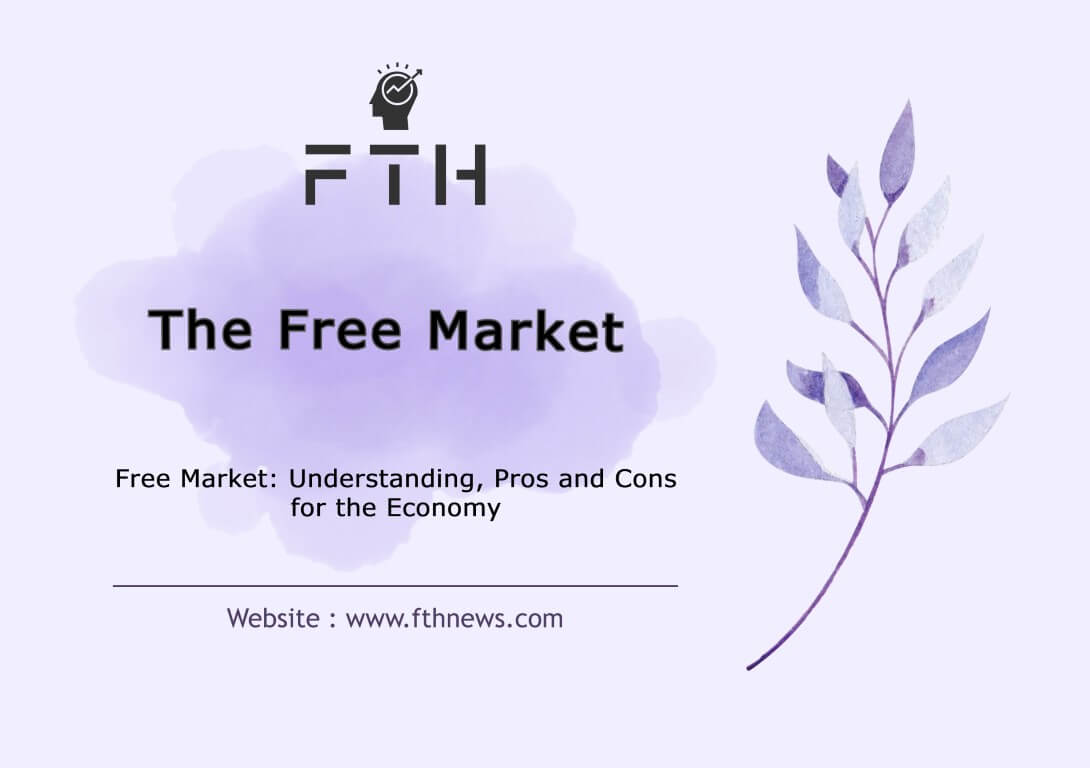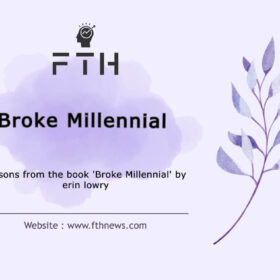
Free Market: Understanding, Advantages and Disadvantages on the Economy
Many economists and market analysts assert that the key to addressing a country’s economic challenges and fostering cultural development lies in embracing a free-market economy. Understanding the fundamentals of a free market is essential for those entering this field.
While some refer to it as an ‘ideal’ rather than a practical reality within a nation’s economy, striving to approach this ideal situation is of paramount importance.
what exactly is a free market economy?
A free market economy, often referred to simply as a free market, is a system where the forces of supply and demand primarily determine pricing.
In such an economy, government policies or mandated pricing have little to no influence.
In essence, it is an economy in which external factors do not dictate market direction; instead, everything is determined by the market itself.
A Deeper Understanding of the Free Market
The term “free market” is often used interchangeably with “free capitalism.” When people refer to the “free market,” they typically envision an economic system characterized by competition, minimal barriers, and private transactions between buyers and sellers.
However, a more comprehensive definition encompasses any voluntary economic activity that isn’t subject to coercive central authority.
Under this broader definition, both free-market capitalism and voluntary socialism can be considered as examples of free markets, even when common ownership of the means of production is involved. A key distinguishing feature is the absence of mandatory restrictions on economic activity.
In simpler terms, a free market is an economic system driven by the forces of supply and demand, as opposed to a system regulated by government controls. On the spectrum of this definition, it stands in stark contrast to a command economy, where a central government agency plans production, resource allocation, and sets prices. In a free market, firms and resources are privately owned, and they are free to engage in trade with one another.
Economists define a free market as a marketplace in which products are exchanged through voluntary transactions between willing buyers and sellers. For instance, purchasing food and goods at prices determined by farmers exemplifies economic exchange. Similarly, paying a monthly salary to a worker is another case of economic exchange in the context of employment.
In a free or pure market economy, sellers of various goods face minimal barriers. Essentially, they can sell any product they desire at any price they choose. However, in reality, such a perfectly unregulated economic system is rare. Tariffs on imports and exports, along with legal restrictions, often create obstacles to the free market.
Characteristics of a Free Market Economy:
Private Ownership of Resources:
In a this economy, a significant portion of resources is privately owned by individuals or private sector companies, not by a central government agency. This ownership gives individuals and entities complete control over the means of production, allocation, exchange of products, and the labor supply.
Freedom of Participation:
An essential feature of a this economy is the freedom of participation. Anyone can choose to participate voluntarily, whether in the production or consumption of a particular product. Companies and individuals have the liberty to produce or purchase as much of a product as they desire.
Free Price System:
The cornerstone of a free market economy is the determination of prices based on supply and demand, allowing for market-driven pricing.
No Forced Transactions:
In a free market, transactions occur voluntarily, driven by the choices of buyers and sellers. There is no coercion, and decisions are made through mutual agreement.
Free Competition:
Competition thrives in a market economy. Anyone with the capacity to supply goods or services can participate and compete without artificial barriers, fostering innovation and variety.
Access to Information:
Consumers have access to information, enabling them to make informed purchasing decisions. This access empowers consumers to choose products and services that meet their needs.
Limited Government Oversight:
In a free market, government intervention is minimal or nonexistent. This means that regulatory oversight is limited, allowing businesses and individuals greater autonomy.
Consumer Responsibility:
In a free market economy, consumers take responsibility for their purchasing decisions. Their choices are driven by personal needs and preferences rather than external pressures.
Negotiated Relationships:
Businesses can sell their products or services at prices determined by consumers’ willingness to pay, while workers negotiate their wages with employers based on market conditions.
These characteristics collectively define a free market economy, where voluntary exchange and competition drive economic activities.
Advantages of the Free Market:
The lack of government influence in a free market economy bestows companies and individuals with a wide range of freedoms. These freedoms offer several advantages:
Freedom to Innovate:
In a free market economy, business owners have the freedom to generate new ideas and products based on consumer needs. They can create innovative products and offer new services without waiting for government directives.
Entrepreneurs conduct their own research to identify popular trends and consumer demands, which drives innovation.The presence of multiple private firms in the market often leads to healthy competition. Each company strives to improve its products and services to gain a competitive edge, resulting in continuous innovation and product enhancements.
Consumer Centric Choices:
In a free market economic system, it is the consumers who play a pivotal role in determining the success or failure of products and services. When presented with multiple product options, consumers assess the features and value of each, making choices based on their preferences and needs.Consumers also significantly influence pricing.
Manufacturers must find a balance between setting a price that ensures profitability (the break-even price) and making the product affordable for the average consumer. This dynamic ensures that businesses are motivated to meet consumer demands and offer products that cater to their preferences.
Efficient Allocation of Resources:
In a free market, resources are allocated efficiently based on supply and demand. Resources naturally flow towards products and services that consumers desire, eliminating wasteful allocation that can occur in more centrally planned economies.
Economic Growth and Job Creation:
The competitive nature of a free market spurs economic growth. Entrepreneurs and businesses create jobs as they expand, and this job creation contributes to a stronger economy. Additionally, the potential for profits motivates businesses to invest in research, development, and innovation.
Variety and Diversity of Products:
Free markets offer a wide variety of products and services, catering to diverse consumer preferences. The competition encourages businesses to diversify and specialize, resulting in a broader range of choices for consumers.
Individual Freedom and Autonomy:
A free market economy provides individuals with the freedom to pursue their entrepreneurial ambitions, make personal economic decisions, and chart their own paths to success. It respects individual liberties and economic independence.
Disadvantages of Free Markets:
While free markets offer numerous advantages, they also come with several drawbacks:
Profit-Seeking Motives:
One of the disadvantages of a free market is that some producers may enter it solely with the motive of making a profit. While seeking profit is a natural and legitimate goal in business, it’s essential that the primary focus remains on meeting the needs of workers and consumers within this market.In simpler terms, companies should not compromise the safety of their workers, environmental standards, or ethical principles solely to maximize profit. For instance, the Deepwater Horizon oil spill in 2010 became one of the largest environmental disasters due to the company’s decision to use subpar cement to cut costs, leading to catastrophic consequences.
Market Failures:
Sometimes, the conditions in a it can spiral out of control, leading to unfortunate consequences. Historical examples include the Great Depression of the 1930 s and the real estate market crash of 2008. Such market failures can result in devastating effects, including high unemployment rates, homelessness, and economic instability.It’s important to note that free markets, while generally efficient, are not immune to cyclical economic downturns and crises.
Influence of Profit-Seeking Lobbies:
As it’s often impractical to establish a completely unrestricted free markets, various interest groups, including commercial companies and individuals, may engage in lobbying efforts to influence government regulations and policies for their own gain.These profit-seeking lobbies can lead to regulatory capture, where the interests of specific industries or corporations take precedence over the broader public interest. This can result in regulations that favor certain groups, leading to market distortions and reduced competition.
Income Inequality:
Free markets can sometimes exacerbate income inequality. While they have the potential to create economic growth, the benefits of that growth do not always reach all segments of society equally. The wealthy may benefit disproportionately, leading to disparities in wealth distribution.
Short-Term Focus:
In a free market, businesses often prioritize short-term profits over long-term sustainability. This focus can lead to decisions that neglect environmental concerns, employee welfare, and the social impact of their operations.
It’s important to recognize that a well-functioning free market economy should ideally strike a balance between individual economic freedom and necessary government regulations to address these disadvantages.
Government interventions are often aimed at mitigating the negative effects of a completely unregulated market while preserving the positive aspects of competition.
The relationship between a free market economy and the capitalist system
1. Interdependence:
A free market economy is a system in which economic activities, such as the production and exchange of goods and services, are primarily determined by the forces of supply and demand without significant government intervention. Capitalism, on the other hand, is an economic and political system that emphasizes private ownership of the means of production and encourages capital accumulation. In a sense, capitalism provides the foundation for a free market.
2. Private Ownership:
Both capitalism and a free economy place a strong emphasis on private ownership. In a capitalist system, individuals or private sector entities have the right to own and control resources, businesses, and property. This private ownership extends to the free market, where private individuals and businesses are free to own and operate enterprises, and compete in the market.
3. Competition:
Competitive markets are a core element of both capitalism and a free economy. In capitalism, competition among businesses is encouraged, as it is believed to lead to efficient resource allocation and innovation. the competitive forces of supply and demand drive pricing, quality, and choice.
4. Individual Rights:
Capitalism recognizes and values individual property rights and the freedom to engage in voluntary transactions and exchanges. Similarly, a free economy upholds individual rights to engage in economic activities and make choices based on their preferences and interests.
5. Wealth and Capital Accumulation:
Capitalism encourages capital accumulation and the generation of wealth. In a IT, those who accumulate wealth and capital can invest and engage in economic activities of their choice, often making financial decisions based on their resources.
6. Economic Decision-Making:
In both systems, financial decisions are primarily made by individuals, businesses, or investors based on their financial capacity and judgment. The distribution of goods and services, as well as pricing, is determined through market competition, reflecting the principles of capitalism.
It’s important to note that while the two systems are closely related, no country operates under a purely free market economy or a purely capitalist system. Most nations have mixed economies, which combine elements of capitalism and government intervention to various degrees. These mixtures are designed to strike a balance between the efficiency and innovation of free markets and the need for regulatory oversight and social safety nets.
FAQ
In simple terms, a free market is an economic system where buyers and sellers make transactions and determine prices without significant government interference. It’s a place where supply and demand set the rules, and people or businesses can freely trade goods and services based on their preferences and needs.
One of the best examples of a free market is the global stock market, where buyers and sellers trade stocks, bonds, and other financial instruments. In a stock market, prices are primarily determined by supply and demand forces, and government regulations are relatively minimal, allowing investors to make their own choices about buying and selling. While it’s not a perfect representation of a completely free market, it demonstrates key elements of market dynamics, competition, and individual decision-making.
A free market can be a powerful engine for innovation and economic growth but may also lead to inequality and instability, so its goodness depends on how it’s managed and regulated.














